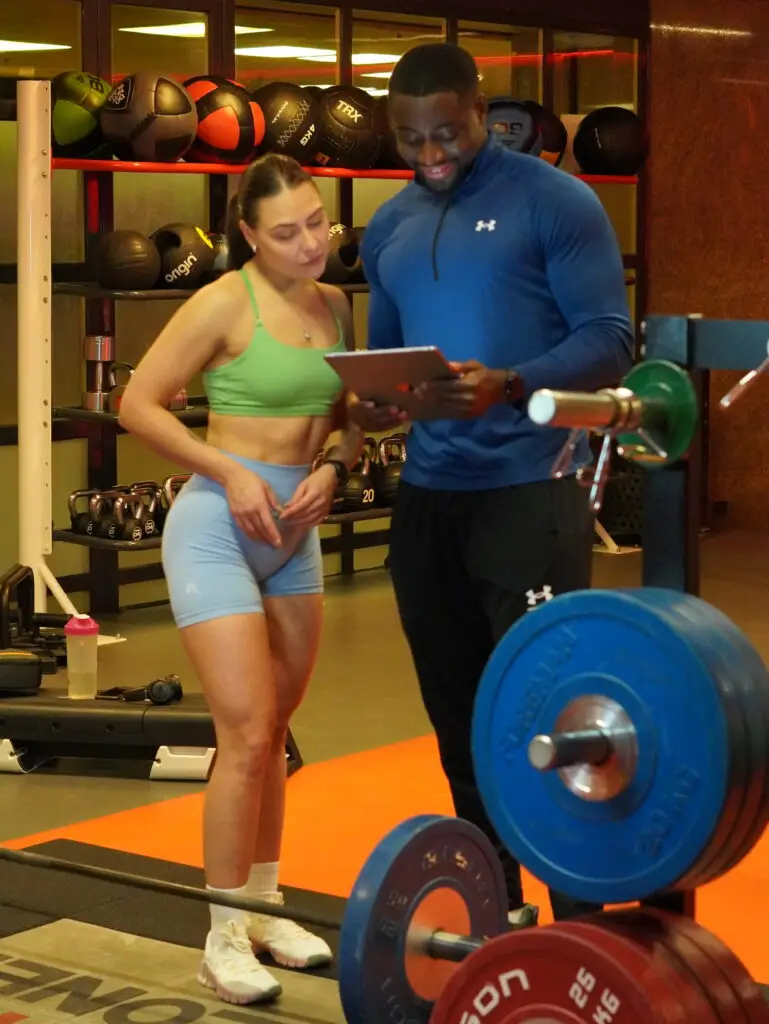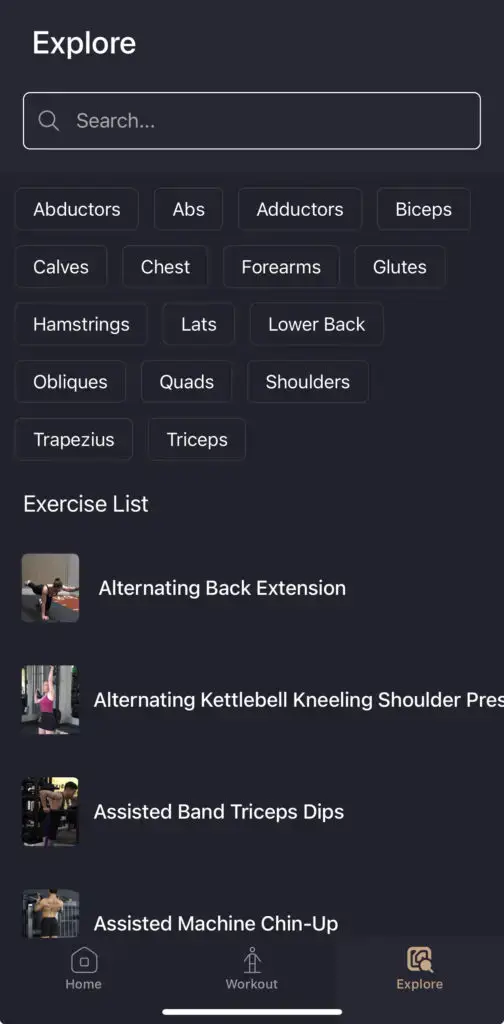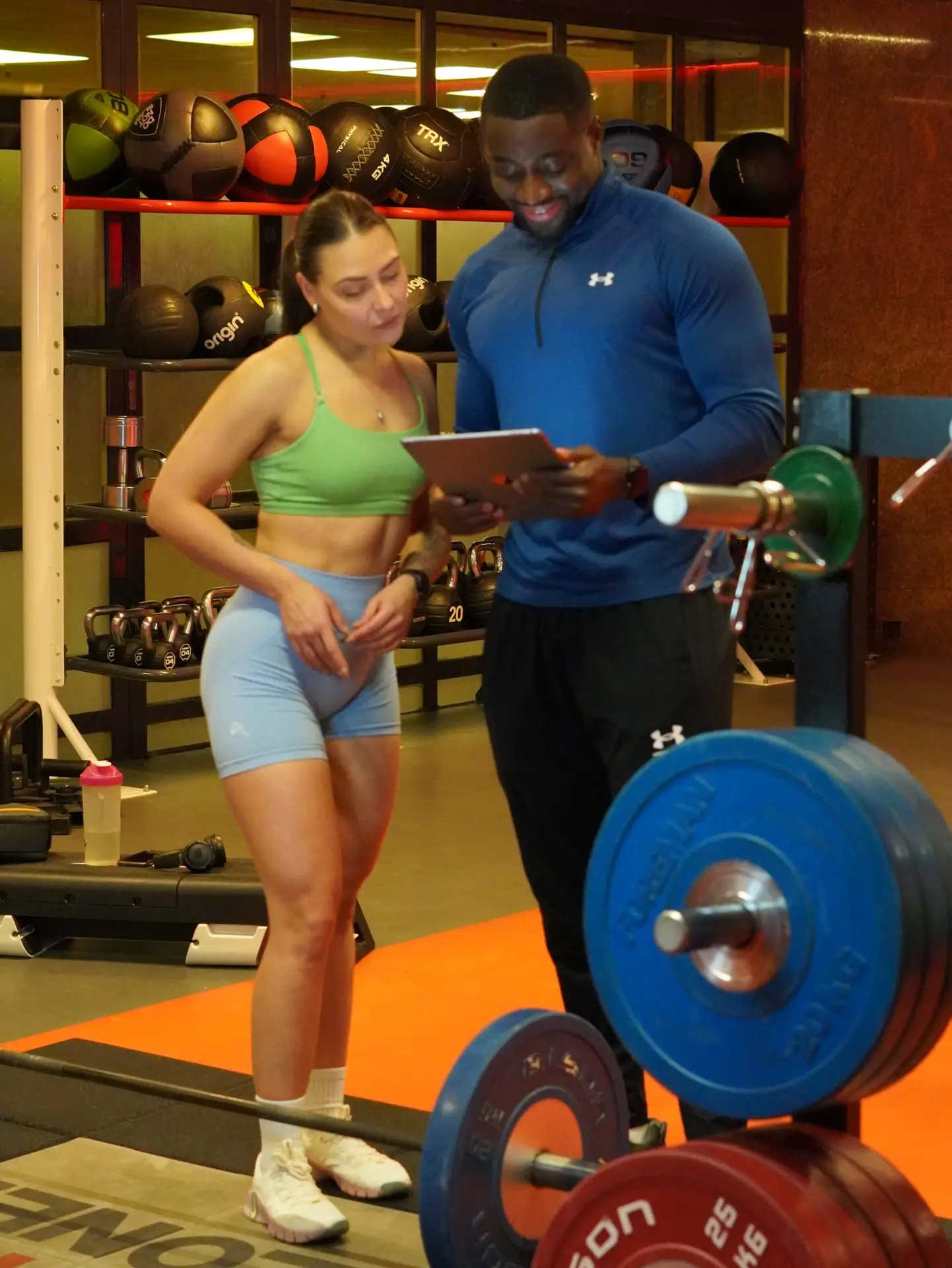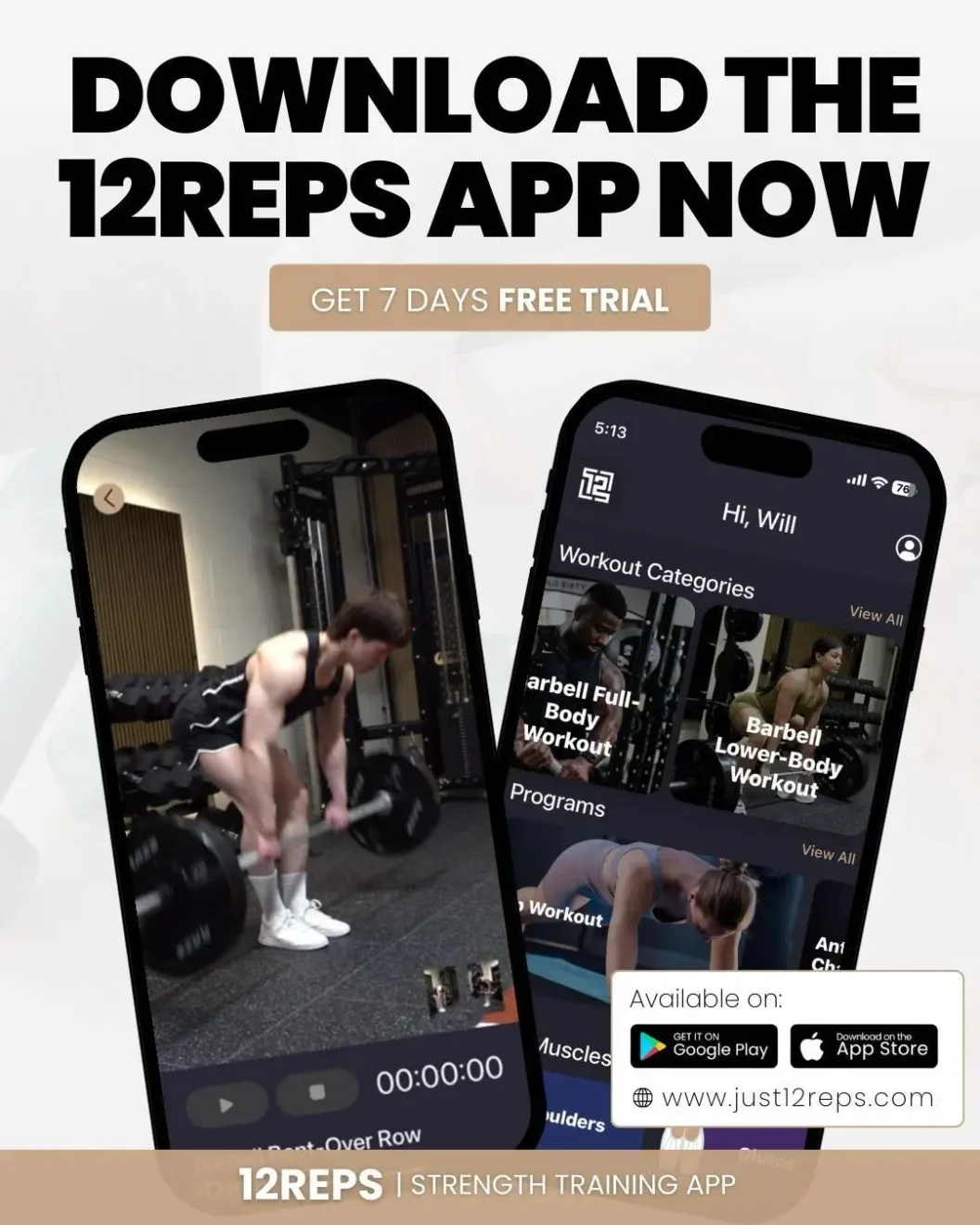I often hear people say they don’t have enough time to train. They think they need to spend hours in the gym every day, splitting their body parts into complex routines. But what if I told you there’s a more innovative, more efficient way to build muscle and get stronger, even with a busy schedule? Enter the full-body workout.
For years, the fitness world has been obsessed with intricate split routines – such as chest day, leg day, and arm day. While these have their place, they’re not always the best fit for everyone, especially if you’re starting, have limited time, or want balanced development. Full-body workouts are a game-changer, allowing you to hit all your major muscle groups in a single session, multiple times a week.
In this article, I’ll break down why full-body workouts are so effective, how they can lead to incredible gains in both strength and muscle, and how the 12Reps app is designed to be your perfect companion for mastering this powerful training approach. We’ll challenge the idea that you need to live in the gym to see results and show you how to train smarter, not just longer.
Written by Will Duru, BSc (Hons) Sport and Exercise Science, Award-winning Personal Trainer.

What is a Full-Body Workout? Training Smarter, Not Longer
Let’s clear up any confusion right away. A full-body workout is exactly what it sounds like: a training session where you work all your major muscle groups – your legs, back, chest, shoulders, and arms – in one go. Instead of dedicating an entire day to just your chest, you’ll do a few exercises for your chest, then move on to your back, and so on.
This approach stands in contrast to the more common split routines that many people follow. In a split routine, you might have a ‘push day’ (chest, shoulders, triceps), a ‘pull day’ (back, biceps), and a ‘leg day’. While splits can be effective, especially for very advanced lifters or those with specific bodybuilding goals, they often require more days in the gym and can lead to less frequent stimulation of each muscle group.
Think of it this way: if you train chest only once a week on a split, your chest muscles are only getting a growth signal every seven days. With a full-body routine, you might train your chest three times a week, giving it three growth signals. From a Sport and Exercise Science perspective, this increased frequency can be a powerful driver for muscle growth and strength development, especially for beginners and intermediate lifters. Your muscles respond better to more frequent, rather than just more intense, stimulation.
It’s about training smarter, not necessarily longer. You’re not spending hours on each muscle group; instead, you’re hitting them effectively and then allowing them to recover before the next session. This efficiency is a huge win for anyone with a busy schedule, like the City professionals I’ve trained for years.
The Undeniable Benefits of Full-Body Training
So, why should you consider a full-body workout? As someone who’s guided countless clients, from complete beginners to seasoned athletes, I can tell you the benefits are compelling, especially when time is a precious commodity.
1. Increased Frequency: Stimulate Muscles More Often for Growth
This is the most significant advantage, particularly for muscle growth (hypertrophy). When you train each major muscle group multiple times a week (e.g., 2-3 times), you’re sending more frequent signals for muscle protein synthesis – the process by which your body repairs and builds new muscle tissue. Research consistently shows that higher training frequency, within a sensible volume, can lead to superior gains for many individuals [1]. Instead of waiting a whole week for your chest to be stimulated again, you’re getting a growth stimulus every 2-3 days. This constant, gentle nudge is incredibly effective.
2. Higher Calorie Burn: More Muscles Working, More Energy Expended
Think about it: if you’re working your legs, back, and chest all in one session, you’re engaging a massive amount of muscle mass. This requires more energy from your body, leading to a higher calorie burn during the workout itself. This can be a huge advantage for weight management and fat loss. Furthermore, the more muscle you build, the higher your resting metabolism becomes, meaning you burn more calories even when you’re not exercising. Full-body workouts are a fantastic way to maximise this metabolic effect.
3. Improved Recovery: Allows More Rest for Individual Muscle Groups Between Sessions
This might sound counter-intuitive, but it’s true. While you’re training your whole body, you’re typically doing fewer sets per muscle group in a single session compared to a body part split. This means each muscle group isn’t completely exhausted. For example, you might do 3-4 sets for chest on a full-body day, compared to 9-12 sets on a dedicated chest day. This allows for quicker recovery of individual muscle groups, so they’re ready to be trained again sooner. This balanced approach reduces the risk of overtraining specific muscles and helps maintain consistent progress.
4. Time Efficiency: Fewer Gym Days Needed
For busy professionals, this is a game-changer. Instead of needing 4-5 days in the gym to hit all your muscle groups with a split routine, you can achieve excellent results with just 2-3 full-body workouts per week. This frees up valuable time for work, family, and other commitments, making your fitness routine sustainable in the long run. It’s about fitting fitness into your life, not fitting your life around fitness.
5. Beginner Friendly: Builds Foundational Strength and Movement Patterns
If you’re new to strength training, full-body workouts are an ideal starting point. They help you learn and reinforce fundamental movement patterns (like squatting, hinging, pushing, pulling) more frequently. This repetition is crucial for developing proper form, building body awareness, and strengthening the neural pathways between your brain and muscles. It establishes a strong, balanced foundation before you even consider more advanced training methods.
6. Balanced Development: Ensures No Muscle Group is Neglected
With full-body workouts, it’s much harder to neglect a muscle group accidentally. Because you’re training everything each session, you’re less likely to skip a day and miss out on training a particular body part. This leads to more balanced muscular development, reducing imbalances and contributing to overall functional strength and injury prevention.
In essence, full-body training is a highly effective, scientifically sound, and practical approach to building strength and muscle, particularly for individuals who need to maximise their training time. It’s about consistent, intelligent stimulation that yields impressive results.
Designing Your Effective Full-Body Workout
Now that you’re convinced of the power of full-body workouts, let’s talk about how to put one together. The key here is selecting smart exercises and adopting a balanced approach. As a Sport and Exercise Science expert, I always recommend focusing on compound movements.
Focus on Compound Movements
Compound movements are exercises that involve multiple joints and muscle groups working together. Think of them as your biggest bang-for-your-buck exercises. They are incredibly efficient because they engage more muscles simultaneously, leading to greater strength gains and muscle growth. They also mimic real-life movements, making you stronger for everyday activities.
Here are the core compound movements you should include:
- Squat Variation: Works your quads, glutes, hamstrings, and core. (e.g., Barbell Squat, Goblet Squat, Dumbbell Squat)
- Hinge Variation: Works your glutes, hamstrings, and lower back. (e.g., Deadlift, Romanian Deadlift, Good Mornings)
- Horizontal Push: Works your chest, front shoulders, and triceps. (e.g., Bench Press, Dumbbell Press, Push-ups)
- Horizontal Pull: Works your back (lats, rhomboids) and biceps. (e.g., Barbell Row, Dumbbell Row, Seated Cable Row)
- Vertical Push: Works your shoulders and triceps. (e.g., Overhead Press, Dumbbell Shoulder Press)
- Vertical Pull: Works your back (lats) and biceps. (e.g., Pull-ups, Lat Pulldowns)
For a well-rounded full-body workout, you’ll typically pick one exercise from each of these categories.
Sample Full-Body Workout Routines
Here are a couple of sample routines to give you an idea. Remember, these are templates, and the 12Reps app can help you customize them perfectly for your needs.
Sample 2-Day Full-Body Workout Week (e.g., Monday & Thursday)
This is great if you’re very busy or just starting out. It allows for plenty of recovery time.
Workout A (Monday):
- Goblet Squat: 4 sets of 8-12 reps
- Dumbbell Bench Press: 4 sets of 8-12 reps
- Dumbbell Row: 4 sets of 8-12 reps
- Overhead Press (Dumbbell or Barbell): 3 sets of 8-12 reps
- Plank: 3 sets, hold for 30-60 seconds
Workout B (Thursday):
- Romanian Deadlift (Dumbbell or Barbell): 4 sets of 8-12 reps
- Push-ups (on knees or incline if needed): 4 sets of as many reps as possible (AMRAP)
- Lat Pulldown (or Assisted Pull-up): 4 sets of 8-12 reps
- Walking Lunges: 4 sets of 10-15 reps per leg
- Face Pulls: 4 sets of 12-15 reps
Sample 3-Day Full-Body Workout Week (e.g., Monday, Wednesday, Friday)
This is a very popular and effective approach for consistent gains. You can alternate between Workout A and Workout B.
Workout A (Monday & Friday):
- Barbell Squat: 3-4 sets of 6-10 reps
- Barbell Bench Press: 3-4 sets of 6-10 reps
- Barbell Row: 3-4 sets of 6-10 reps
- Overhead Press (Barbell): 3-4 sets of 6-10 reps
- Bicep Curls: 3 sets of 10-15 reps
- Tricep Pushdowns: 3 sets of 10-15 reps
Workout B (Wednesday):
- Deadlift: 3-4 sets of 4-8 reps
- Incline Dumbbell Press: 3-4 sets of 8-12 reps
- Pull-ups (or Lat Pulldown): 3-4 sets of 6-10 reps
- Leg Press: 3-4 sets of 10-15 reps
- Calf Raises: 3 sets of 15-20 reps
- Ab Rollouts: 3 sets of 10-15 reps
Sets, Reps, and Rest Guidelines
- Sets: For most compound movements, 3-4 sets are a good starting point. For isolation exercises (like bicep curls), 2-3 sets are usually enough.
- Reps: The rep range depends on your goal. For strength, aim for 4-8 reps. For muscle growth (hypertrophy), 8-12 reps is ideal. For endurance, 12-15+ reps. For full-body workouts, a mix is often effective.
- Rest: For compound movements, rest 2-3 minutes between sets to allow for good recovery and performance. For isolation exercises, 60-90 seconds is usually sufficient.
Remember, the goal is to perform each exercise with good form. Don’t just chase numbers. Quality over quantity, always. This is where the 12Reps app becomes incredibly useful, as it guides you through proper form and helps you track your progress, ensuring you’re always training effectively.

Progressive Overload in Full-Body Workouts
One of the most fundamental principles of strength training, regardless of your workout split, is the concept of progressive overload. To continue building muscle and staying strong, you need to challenge your body continually. If you continue to do the same thing, your body will adapt, and your progress will eventually plateau. As a Sport and Exercise Science professional, I can tell you this is a non-negotiable for long-term gains.
How to Keep Making Gains
In a full-body workout, you have several ways to apply progressive overload:
- Increase the Weight: This is the most common and often most effective method. If you were lifting 10kg for 10 reps last week, try 12.5kg this week (if your form allows).
- Increase the Reps: If you can comfortably hit the top end of your rep range (e.g., 12 reps when aiming for 8-12), try to add a few more reps with the same weight.
- Increase the Sets: You can add an extra set to an exercise, but be mindful of overall workout duration and recovery.
- Improve Your Form: While not a direct measure of overload, better form means you’re targeting the muscle more effectively, which can lead to better gains even with the same weight. It also reduces injury risk.
- Decrease Rest Time: If you’re resting for 90 seconds between sets, try cutting it down to 60 seconds. This increases the density of your workout.
- Increase Time Under Tension (TUT): Slowing down your reps, especially the lowering (eccentric) phase, can increase the time your muscles are working, leading to more stimulus.
Why It’s Crucial for Full-Body Training
Because you’re hitting each muscle group multiple times a week in a full-body routine, you have more opportunities to apply progressive overload. This consistent stimulus, combined with adequate recovery, is what drives adaptation and growth. You’re not waiting a whole week to try and beat your last performance; you’re doing it every few days.
It’s essential to track your progress to ensure you’re consistently applying overload. This means noting down the weight, sets, and reps for each exercise. Without tracking, it’s difficult to determine if you’re making progress or simply going through the motions. This is where a smart training app becomes indispensable.

12Reps: Your Full-Body Workout Companion
By now, you should be convinced that full-body workouts are a powerful, efficient, and effective way to build strength and muscle, especially for busy individuals. But how do you put all this into practice, track your progress, and ensure you’re consistently applying progressive overload without getting overwhelmed? This is precisely where the 12Reps app becomes your indispensable training partner.
I designed 12Reps to take the guesswork out of your training, allowing you to focus on what truly matters: performing your exercises with good form and feeling your muscles work. Here’s how 12Reps empowers your full-body training journey:
1. Personalised Full-Body Program Generation
Forget generic workout plans. 12Reps uses its smart filtering system to create personalised full-body programs tailored to your goals, experience level, and available equipment. Whether you’re training 2 or 3 days a week, at home or in a fully equipped gym, 12Reps can generate a routine that fits your needs. This means you get a structured, effective plan without having to spend hours researching and designing it yourself.
2. Detailed Exercise Demonstrations and Form Cues
Mastering compound movements is key to effective full-body training. 12Reps provides clear, high-quality video demonstrations for every exercise. These aren’t just quick clips; they show proper form from multiple angles, highlighting key cues to ensure you’re performing each movement safely and effectively. This visual guidance is crucial for learning new exercises and refining your technique, helping you get the most out of every rep.
3. Effortless Tracking and Volume Analytics
Remember how important progressive overload is? 12Reps makes tracking your workouts incredibly easy. You can log your sets, reps, and weights for every exercise. But it goes beyond simple logging. The app provides advanced analytics that visualise your training volume over time. You can see your total volume per exercise, per muscle group, and across your entire training week. This data-driven approach helps you ensure you’re consistently challenging yourself and staying within your optimal training zones for growth and recovery.
4. Adaptive Programming for Continuous Progress
12Reps isn’t a static program. As you get stronger, the app can adapt your workouts to ensure you continue to apply progressive overload. It helps you identify when to increase weight, reps, or sets, keeping your training challenging and effective. This intelligent adaptation ensures you’re always progressing, avoiding plateaus and maximising your long-term gains.
5. Focus on the Workout, Not the Logistics
With 12Reps, you spend less time figuring out what to do next and more time actually training. The app guides you through each exercise, tracks your rest times, and keeps a comprehensive record of your performance. This seamless experience allows you to maintain focus and intensity throughout your full-body workout, making every minute in the gym count.
In essence, 12Reps is designed to be the ultimate tool for anyone embracing full-body training. It provides the structure, guidance, and tracking you need to train efficiently, effectively, and intelligently, ensuring you unlock your full potential for strength and muscle growth.
Conclusion: Your Path to Consistent Gains with Full-Body Training
Full-body workouts are not just a trend; they are a scientifically sound and efficient approach to strength training, particularly for those with busy lives or anyone seeking balanced, consistent gains. As a Sport and Exercise Science professional and the founder of 12Reps, I’ve seen firsthand how this method can transform physiques and build real strength.
We’ve explored the undeniable benefits: increased training frequency for better muscle stimulation, higher calorie burn for fat loss, improved recovery, and unparalleled time efficiency. By focusing on compound movements and consistently applying progressive overload, you can achieve remarkable results without spending endless hours in the gym.
And this is where the 12Reps app truly shines. It’s more than just a workout tracker; it’s your intelligent training partner. From generating personalised full-body programs with its smart filtering, to providing detailed exercise demonstrations and form cues, and offering advanced analytics to track your volume and progress, 12Reps empowers you to train smarter, not just harder. It takes the complexity out of programming, allowing you to focus on the execution and the crucial mind-muscle connection.
So, if you’re ready to unlock your full potential, embrace the power of full-body workouts. Let 12Reps guide you on a path to consistent strength, impressive muscle growth, and a more efficient, sustainable fitness journey. It’s time to train with purpose and see the results you’ve been working for.








